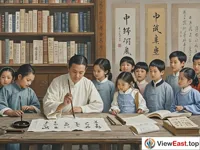





The 19th century in China's modern history was undoubtedly a time of dramatic changes. During this period, China experienced a transformation from feudal seclusion to forced openness, and its trade and diplomacy underwent earth-shaking changes. This article will take you back to that era in China to explore the evolution of its trade and diplomacy, and how these changes affected the inheritance and development of Chinese culture.
I. The Transformation of Trade: From Self-Sufficiency to Open Markets
Before the 19th century, China had a long-standing agricultural-based self-sufficient economy. However, with the invasion of Western powers, the pattern of China's trade underwent a fundamental change. After the Opium War, China was forced to sign a series of unequal treaties, opening up multiple trading ports, and the goods and capital of Western powers flooded in, gradually integrating China into the world capitalist market system.
II. The Challenge of Diplomacy: From Tribute System to Treaty Relations
In the field of diplomacy, China also experienced a transition from a tribute system to treaty relations. The tribute system was once the main way China interacted with neighboring countries, reflecting China's cultural influence and political status. However, in the 19th century, China had to accept treaties imposed by Western powers, which severely damaged China's sovereignty and interests.
III. The Open Door Policy: America's 'Equal Opportunity'
In 1899, the United States proposed the "Open Door" policy, advocating for "equal benefits and opportunities" in China. Although this policy temporarily prevented China from being carved up, it actually intensified the semi-colonial status of China, with China's trade and diplomatic policies becoming more controlled by Western powers.
IV. Cultural Confidence and Heritage
Despite the immense external pressures faced by China in the 19th century, the essence of Chinese culture did not disappear. On the contrary, cultural exchanges during this period became more frequent, and traditional Chinese culture collided and integrated with Western culture. From ancient poetry and calligraphy to the modern New Culture Movement, Chinese culture continuously renewed and developed amidst challenges.